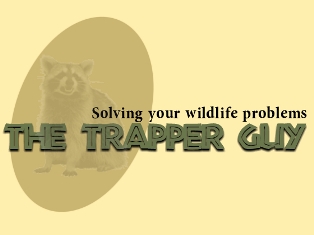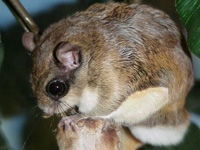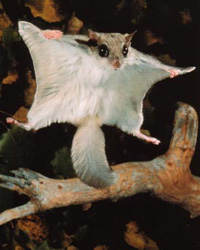| |

Call
now
to solve your Flying Squirrel problems.
727-710-0373
Click
here for a free estimate!
Southern Flying Squirrel
Southern Flying Squirrels are located throughout the Tampa Bay area. They are rarely seen as they are a nocturnal species of squirrel.
They actually do not fly but glide through the air with a piece of skin between the front and rear limbs. They are a small squirrel and have very large eyes.
Flying squirrels can be a nuisance because of their nesting habits. Like many local animals they like to nest in hollowed out dead trees but most urban areas don't have dead trees. The next best place is your attic. They are also communal in nature so there can be many of them nesting in one attic.
The Trapper Guy can refer you to a licensed professional to help you solve your Flying Squirrel problems.
Call
today to have your Flying Squirrel problem
resolved!
727-710-0373
|
Excerpt
from Wikipedia article:
Southern flying squirrels have grey brown fur on top with darker flanks and are a cream color underneath. They have large dark eyes and a flattened tail. They have a furry membrane called a patagium which extends between the front and rear legs, used to glide through the air. Southern Flying Squirrels feed on fruit and nuts from trees such as red and white oak, hickory and beech. They store food, especially acorns, for winter consumption. They also dine on insects, buds, mushrooms, mycorrhizal fungi, carrion, bird eggs and nestlings and flowers. Predators include snakes, owls, hawks and raccoons. Domestic house cats can be dangerous to these animals. Although graceful in flight, they are particularly vulnerable on the ground.
Although the squirrels will make outside nests, especially in pine woods, they prefer to nest in holes in dead trees, snags or attics. They often use these nesting holes communally, especially in winter, when huddling gives them significant energy savings. They readily use artificial nest boxes. They choose holes with smaller entrances than those used by the sympatric Eastern gray squirrel (Sciurus carolinensis). Sometimes they use holes that have been made by woodpeckers such as the Red-cockaded Woodpecker (Picoides borealis); since this is an endangered species, the squirrels are sometimes removed from areas where the woodpeckers nest, though the usefulness of this practice has been disputed. They tend to avoid areas of forest that have been harvested recently.
Both in the wild and in captivity they can produce two litters each year (with 2-7 young per litter), [citation? it is questionable whether or not the same females will breed twice in one year but males definitely will] in early spring and mid-summer. The gestation period is approximately 40 days. Young are born without fur or any capabilities of its own. Their ears open at 2 to 6 days old, and fur grows in by 7 days. Their eyes don't open until they are 24-30 days old. Parents leave their young 65 days after they are born. The young then become fully independent at 120 days of age.
Southern Flying Squirrels show substantial homing abilities, and can return to their nests if artificially removed to distances of up to a kilometre. Their home ranges may be up to 40,000 square meters for females and double that for males, tending to be larger at the northern extreme of their range.
|
|
|

Licensed and insured nuisance wildlife
trapper. Let me help
you with your Flying Squirrel
problems. |
| 
Southern Flying Squirrel
The
Trapper Guy is not a pest control
company. I do not
use poisons or service bugs.
|

|
|